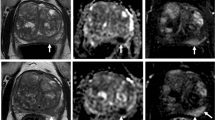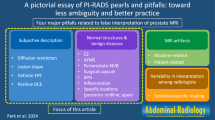Abstract
Brachytherapy, also known as sealed source or internal radiation therapy, involves placement of a radioactive source immediately adjacent to or within tumor, thus enabling delivery of a localized high dose of radiation. Compared with external beam radiation which must first pass through non-target tissues, brachytherapy results in less radiation dose to normal tissues. In the past decade, brachytherapy use has markedly increased, thus radiologists are encountering brachytherapy devices and their associated post-treatment changes to increasing degree. This review will present a variety of brachytherapy devices that radiologists may encounter during diagnostic pelvic imaging with a focus on prostate and gynecologic malignancies. The reader will become familiar with the function, correct position, and potential complications of brachytherapy devices in an effort to improve diagnostic reporting and communication with clinicians.




















Similar content being viewed by others
References
Forssell Gosta (1931) The social fight against cancer. Journal de Radiologie 15:621–634
Laughlin J (1989) Ph.D. Development of the technology of radiation therapy. Radiographics 9(6):1245–1246
Landoni F, Maneo A, Colombo A, et al. (1997) Randomized study of radical surgery versus radiotherapy for stage Ib-IIa cervical cancer. Lancet. 350:535–540
Michaelson MD, Cotter SE, Gargollo PC, et al. (2008) Management of complications of prostate cancer treatment. CA: A Cancer J Clin 58:196–213. doi:10.3322/CA.2008.0002
Kirisits C, Pötter R, Lang S, Dimopoulos J (2005) Wachter- Gerstner N, Georg D. Dose and volume parameters for MRI-based treatment planning in intracavitary brachytherapy for cervical cancer. Int J Radiat Oncol Biol Phys 62:901–911
Cancer facts and figures. 2014 Supplemental Data. Estimated 2014 New Cancer Cases by Site, Sex, & Age. American Cancer Society. http://www.cancer.org/research/cancerfactsstatistics/index Accessed 4/26/14
Boonsirikamchai P, Choi S, Frank SJ, et al. (2013) MR imaging of prostate cancer in radiation oncology: what radiologists need to know. Radiographics 33:741–761
Soylu FN, Eggener S, Oto A (2012) Local staging of prostate cancer with MRI. Diagn Interv Radiol 18:365–373
Buyyounouski MK, Davis BJ, Prestidge BR, et al. (2010) A survey of current clinical practice in permanent and temporary prostate brachytherapy: 2010 update. Brachytherapy 11(2012):299–305
Network NCC (2012) Clinical practice guidelines in oncology: prostate cancer. National Comprehensive Cancer network. vol 2013. Fort Washington: Network NCC
Nicola Schieda, MD, Leonard Avruch, MD, et al. Multi-echo Gradient Recalled Echo Imaging of the Pelvis for Improved Depiction of Brachytherapy Seeds and Fiducial Markers Facilitating Radiotherapy Planning and Treatment of Prostatic Carcinoma. J Magn. Reson. Imaging 2014; 00:000-000
Hegde JV, Mulkern RV, Panych LP, et al. (2013) Multiparametric MRI of prostate cancer: an update on state-of-the-art techniques and their performance in detecting and localizing prostate cancer. J Magn Reson Imaging 37:1035–1054
Coakley FV, Hricak H, Wefer AE, et al. (2001) Brachytherapy for prostate cancer: endorectal MR imaging of local treatment-related changes. Radiology 219:817–821
Soylu FN, Peng Y, Jiang Y, et al. (2013) Seminal vesicle invasion in prostate cancer: evaluation by using multiparametric endorectal MR imaging. Radiology 267:797–806
Bloch BN, Lenkinski RE, Helbich TH, et al. (2007) Prostate postbrachytherapy seed distribution: comparison of high-resolution, contrast-enhanced, T1- and T2-weighted endorectal magnetic resonance imaging versus computed tomography: initial experience. Int J Radiat Oncol Biol Phys 69:70–78
Zelefsky MJ, Valicenti RK, Hunt M, et al (2008) Low-risk prostate cancer. In: Perez and Brandy’s principles and practice of radiation oncology, 5th edn. Lippincott Williams & Wilkins, Philadelphia, pp 339–1483
Davis BJ, Horwitz EM, Lee RW, et al. (2012) American Brachytherapy Society consensus guidelines for Transrectal ultrasound-guided permanent prostate brachytherapy. Brachytherapy 11:6–19
Yablon CM, et al. (2004) Complications of prostate cancer treatment: spectrum of imaging findings. Radiographics 24:181–194
King Christopher R (2002) LDR vs. HDR brachytherapy for localized prostate cancer: the view from radiobiological models. Brachytherapy. 1:219–226
Nout RA, et al. (2010) Vaginal brachytherapy versus pelvic external beam radiotherapy for patients with endometrial cancer of high-intermediate risk (PORTEC-2): an open-label, non-inferiority, randomised trial. Lancet. 375:816–823
Klopp A et al The role of postoperative radiation therapy for endometrial cancer: executive summary of an American Society for Radiation Oncology evidence-based guideline. Prac Rad Oncol 4(3) 137–144
Haie-Meder C, Gerbaulet A, Potter R (2002) Interstitial brachytherapy an gynaecological cancer. In: Gerbaulet A, Potter R (eds) The GEC ESTRO handbook of brachytherapy. ESTRO, Brussels, pp 417–433
Scanlan KA, et al. (2001) Invasive procedures in the female pelvis: value of transabdominal, endovaginal, and endorectal US guidance. Radiographics 21(2):491–506
Nag S, et al (2000) The American Brachytherapy Society recommendations for high-dose-rate brachytherapy for carcinoma of the endometrium. Int J Radiat Oncol Biol Phys 48(3):779–790
Mock M, Knocke T, Fellner C, Pötter R (1998) Analysis of different application systems and CT-controlled planning variants in treatment of primary endometrial carcinomas. Is brachytherapy treatment of the entire uterus technically possible? Strahlenther Onkol 174(6):320–328
Lanciano RM, Martz K, Coia LR, Hanks GE (1991) Tumor and treatment factors improving outcome in stage III-B cervix cancer. Int J Radiat Oncol Biol Phys 20:95–100
Leitao MM, Chi DS (2002) Recurrent cervical cancer. Curr Treat Options Oncol. 3:105–111
Viswanathan AN, Thomadsen B, et al American Society Cervical Cancer Brachytherapy Task Group. http://www.americanbrachytherapy.org/guidelines/cervical_cancer_taskgroup.pdf. Accessed 11/9/14.
Rockey WM, Bhatia SK, Jacobson GM, Kim Y (2013) The dosimetric impact of vaginal balloon-packing on intracavitary high-dose-rate brachytherapy for gynecological cancer. J Contemp Brachyther 5(1):17–22. doi:10.5114/jcb.2013.34449
Swanick CW et al (2015) Optimizing packing contrast for MRI-based intracavitary brachytherapy planning for cervical cancer. Brachytherapy. 2015 Jan 22.
Charra C, Roy P, Coquard R (1998) Outcome of treatment of upper third vaginal recurrences of cervical and endometrial carcinomas with interstitial brachytherapy. Int J Radiat Oncol Biol Phys
Choy D, Wong RL, Sham J (1993) Vaginal template implant for cervical carcinoma with vaginal stenosis or inadvertent diagnosis after hysterectomy. Int J Radiat Oncol Biol Phys 28:457–462
Eifel PJ, Moughan J, Owen J (1999) Patterns of radiotherapy practice for patients with squamous carcinoma of the uterine cervix: Patterns of care study. Int J Radiat Oncol Biol Phys:43–48.
Monk BJ, Tewari K, Burger RA, et al. (1997) A comparison of intracavitary versus interstitial irradiation in the treatment of cervical cancer. Gynecol Oncol 67:241–247
Clifford C, et al. (1995) Brachytherapy-related complications for medically inoperable Stage I endometrial carcinoma. Int J Radiat Oncol 31(1):37–42
Barillot I, Reynaud-Bougnoux A (2006) The use of MRI in planning radiotherapy for gynecological tumors. Cancer Imaging 6:100–106
Viswanathan AN, Dimopoulos J, Kirisits C, Berger D, Pötter R (2007) Computed tomography versus magnetic resonance imaging-based contouring in cervical cancer brachytherapy: results of a prospective trial and preliminary guidelines for standardized contours. Int J Radiat Oncol Biol Phys 68:491–498
Beddy P, Rangarajan RD, Sala E (2011) Role of MRI in intracavitary brachytherapy for cervical cancer: what the radiologist needs to know. Am J Roentgenol. 196(3):W341–W347
Barnes EA, Thomas G, Ackerman I, et al. (2007) Prospective comparison of clinical and computed tomography assessment in detecting uterine perforation with intracavitary brachytherapy for carcinoma of the cervix. Int J Gynecol Cancer 17:821–826
Šegedin B, Gugić J, Petrič P (2013) Uterine perforation—5-year experience on 3D image guided gynaecological brachytherapy at Institute of Oncology Ljubljana. Radiol Oncol 47:154–160
Irvin W, Rice L, Taylor P, Anderson W, Schneider B (2003) Uterine perforation at the time of brachytherapy for carcinoma of the cervix. Gynecol Oncol 90:113–122
Selke P, Roman TN, Souhami L, et al. (1993) Treatment Results of High dose rate brachytherapy in patients with carcinoma of the cervix. Int J Radiat Oncol Biol Phys. 27:803–809
Narayabab P, et al. (2009) Fistulas in malignant gynecologic disease: etiology, imaging, and management. Radiographics. 29:1073–1083
Conflict of interest
None.
Author information
Authors and Affiliations
Corresponding author
Rights and permissions
About this article
Cite this article
Vicens, R.A., Rodriguez, J., Sheplan, L. et al. Brachytherapy in pelvic malignancies: a review for radiologists. Abdom Imaging 40, 2645–2659 (2015). https://doi.org/10.1007/s00261-015-0407-y
Published:
Issue Date:
DOI: https://doi.org/10.1007/s00261-015-0407-y




